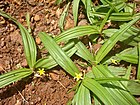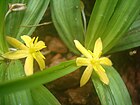Note: This is a project under development. The articles on this wiki are just being initiated and broadly incomplete. You can Help creating new pages.
Curculigo orchioides - Black Musli
Talamuli is a tiny herb that can be seen in the rainy season. They are deep rooted plants with palm like lance shaped leaves and yellow star shaped flowers.
Uses
Piles, Biliousness, Fatigue, Blood related disorders, Bronchitis, Indigestion, Vomiting, Diarrhea, Lumbago, Gonorrhea, Ophthalmia, Gleet, Hydrophobia.
Parts Used
Chemical Composition
Common names
| Language | Common name |
|---|---|
| Kannada | nela tengu, nelathaale gadde, thaala moolike |
| Hindi | kali-moosli, kali-musli |
| Malayalam | nela-pana-kelangu, nelappana-kizhanna, nelppana, nilappana |
| Tamil | nilappanang-kizhangu, nilavilumi, aiyancu, aiyancukkilankutalamuli |
| Telugu | nela-tati-gaddalu, nelaathadi |
| Marathi | bhuyimaddi, kaalimusalee |
| Gujarathi | |
| Punjabi | |
| Kashmiri | |
| Sanskrit | arshoghni, bhutali, mausali, musalirahi, mushali, talamuli, vrishyakanda |
| English |
Properties
Reference: Dravya - Substance, Rasa - Taste, Guna - Qualities, Veerya - Potency, Vipaka - Post-digesion effect, Karma - Pharmacological activity, Prabhava - Therepeutics.
Dravya
Rasa
Madhura (Sweet), Tikta (Bitter)
Guna
Guru (Heavy), Snigdha (Slimy)
Veerya
Ushna (Hot)
Vipaka
Karma
Vata, Pitta
Prabhava
Habit
Identification
Leaf
{{Leaf|Simple|Rosette|rhizome to 15 cm long, oblong, perennial. Leaves 10-15 x 2 cm, lanceolate, plicate, base sheathing, pilose, subsessile.}[2]
Flower
| Type | Size | Color and composition | Stamen | More information |
|---|---|---|---|---|
| Bisexual | Solitary | Yellow | 6 | Flowering and fruiting is from January to September |
Fruit
| Type | Size | Mass | Appearance | Seeds | More information |
|---|---|---|---|---|---|
| Fruit baccate; seeds subglobose. | {{{6}}} |
Other features
List of Ayurvedic medicine in which the herb is used
Where to get the saplings
Mode of Propagation
How to plant/cultivate
Tuber segments of 1.5–2 cm size, containing the apical bud, are collected during February–March and used for propagation. [3]
Commonly seen growing in areas
Photo Gallery
References
External Links
- Ayurvedic Herbs known to be helpful to treat Piles
- Ayurvedic Herbs known to be helpful to treat Biliousness
- Ayurvedic Herbs known to be helpful to treat Fatigue
- Ayurvedic Herbs known to be helpful to treat Blood related disorders
- Ayurvedic Herbs known to be helpful to treat Bronchitis
- Ayurvedic Herbs known to be helpful to treat Indigestion
- Ayurvedic Herbs known to be helpful to treat Vomiting
- Ayurvedic Herbs known to be helpful to treat Diarrhea
- Ayurvedic Herbs known to be helpful to treat Lumbago
- Ayurvedic Herbs known to be helpful to treat Gonorrhea
- Ayurvedic Herbs known to be helpful to treat Ophthalmia
- Ayurvedic Herbs known to be helpful to treat Gleet
- Ayurvedic Herbs known to be helpful to treat Hydrophobia
- Herbs with Leaves used in medicine
- Herbs with Stem used in medicine
- Herbs with Flowers used in medicine
- Herbs with Roots used in medicine
- Herbs with common name in Kannada
- Herbs with common name in Hindi
- Herbs with common name in Malayalam
- Herbs with common name in Tamil
- Herbs with common name in Telugu
- Herbs with common name in Marathi
- Herbs with common name in Sanskrit
- Habit - herb
- Index of Plants which can be propagated by Tuber segment
- Herbs that are commonly seen in the region of Tropical area
- Herbs
- Ayurvedic herbs that don't have seed photos
- Hypoxidaceae




